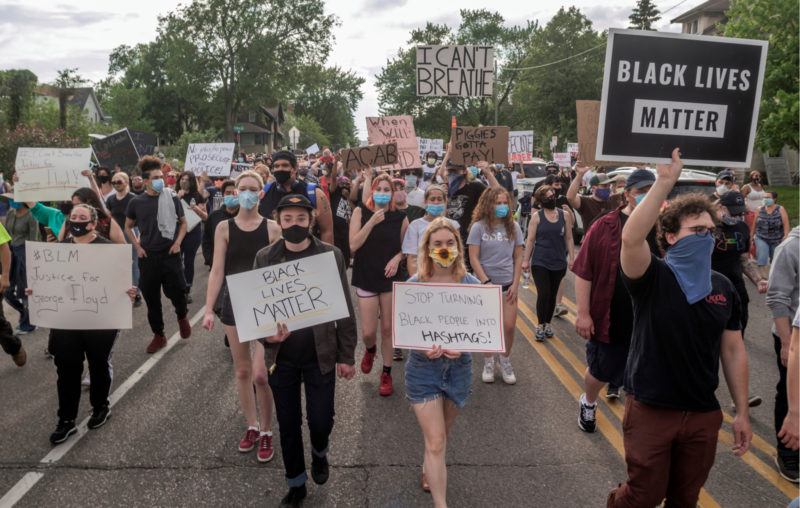That’s One Way to End a Lockdown

There’s an old 18th-century saying about the best-laid plans of mice and men. From such plans – the most prestigious public health professionals working with the most powerful people, deploying for the first time a new way to control disease – we now stand in the midst of rubble.
It seems hard to believe. It was only a few months ago that the United States had a strong economy and a bright future. How we went from domestic peace and prosperity in February 2020 to the madness – cities on fire, military rule, curfews, economic desperation – we see today will be the subject of historical reconstruction for many decades hence. We are already seeing the first drafts written now.
The people in the streets are said to be protesting or rioting, but in other ways this has elements of a rebellion. It’s a rebellion against controls over the population that should never have been imposed – based on law, precedent, and human rights. The American people put up with it for more than two months, even as the strictures and regulations were building a nationwide powderkeg.
The disgusting murder of George Floyd, a man forcibly disemployed under lockdown and allegedly passing a counterfeit $20 bill to escape poverty, was all too familiar. It was the fuse that lit up that powder. The outrage against such police abuses stretches back decades and is reason enough for people from coast to coast to scream: enough.
At the same time, there is much more going on here than police abuse of power. Floyd became such a powerful symbol for people of all races and classes. He could have been any one of us. The boot on the neck smacks of Orwell’s chilling prediction of life under government plans: “If you want a vision of the future, imagine a boot stamping on a human face – forever.”
Americans of all classes, races, and political affiliations refuse to acquiesce to that future. Enough is enough.
The fires that burn in our cities today were born long ago with government impositions in every aspect of our lives. The impositions date back many generations. In the course of three months, the lockdowns stacked the wood; Floyd’s murder was the match.
In mid-March 2020, for fear of a virus, schools were forcibly closed, workers and businesses were arbitrarily divided by governments into essential and nonessential, police powers were deployed to enforce human separation under the strangely clinical name of “social distancing,” stay-home orders went into effect, travel restrictions internationally and even domestically locked us down and separated us (as if viruses care about lines on a map), and hospitals shut for anything but COVID-related illnesses.
It was a perfect central plan, the deployment of a real-life version of plans first laid out in 2006, at least on paper. The plans included no reference to legislatures, public opinion polls or elections, concern for the Bill of Rights, private property, commercial functioning, family rights, religious freedom, or basic freedoms of association – and certainly never accounted for the reality that people don’t like to be muscled by dictators local, state, and federal.
All of this massive apparatus of compulsion and coercion, of course, became our new regime for our own good and our health, or so they have repeatedly said. What’s fascinating looking back is how little any of what we’ve done to our beloved country had anything to do with the realities of the virus called COVID-19.
This particular virus – different from the last one and next one – turned out to be mostly brutal on older populations with comorbidities, particularly vicious in long-term care facilities. For more than 99% of everyone else, it is not much of a disease at all. People are coming to realize this, though it is rarely admitted on your television screens. When you throw out all concerns for human decency in the name of virus control, you have to keep doubling down on the rationale for the panic. Weeks stretched into months, and the excuses kept changing.
It’s no surprise that many of the protesters and rebels on the streets were glad to tell of their incredulity to the meda. The truth about this outrageous government overreach was going to leak out, despite near uniformity of a pro-lockdown position among major media. The trouble is, and perhaps this is a good thing, people have stopped believing. Even the mask mandates backfired: they were universally worn by the protestors.
People do not believe the media, the politicians, the “public health professionals.” They stopped believing in the need to follow the plan. They have started to believe that perhaps freedom offers a better way, even in the presence of a virus.
Now 75 days into the lockdown, and still oppressed by overly formalized models of an organized and scripted re-opening, and 48 hours after our cities lit up and streets filled with angry rebels, there are vast remaining problems.
First, it’s not at all clear whether and to what extent any of the political elites in this country have the slightest clue about what has happened or what to do about it. Second, the economy is now burdened with terrible debt, awful spending plans, and egregious monetary policy. Third, we continue to live with unnecessary and burdensome regulations on our movements and rights.
All three problems need desperately to be addressed.
It’s also time we look toward the future, perhaps with some optimism. Hundreds of unneeded regulations have been suspended in the crisis. New forms of education and health-care delivery have been innovated and practiced. The political class is largely discredited. Many of the overly confident planners who hatched this disaster are hunkered down in hiding. People are unlikely ever to hold the mainstream media in high regard, at least not for a very long time.
The best laid plans: inspired by myopic modelers, eschewing of expert opinions of dissident scientists, disregarding of essential rights, fueled by media fabrications and irresponsibility, imposed by governments at all levels. It’s a new chapter of The Road to Serfdom.
Let us write yet another chapter in which we learn something from this calamity and re-embrace the idea of human freedom.












